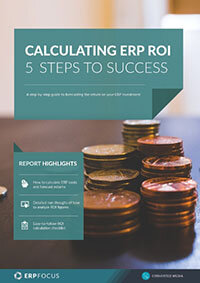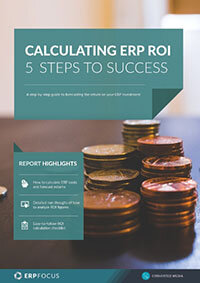Putting a figure on your ERP ROI
Regardless of the particular ERP system, the financial value of a resources-driven system typically comes down to ROI. This is because most C-level folks tend to validate success, or failure, on the basis of constellations of numbers provided by a company’s financial cadre.
More times than not, direct variances between a system’s investment (cost), versus its derived revenue (return) offer’s a pretty easy way to determine whether a technical component is worth its cost, or just a blinking sign announcing that you’re about to fall off the road. However, and with no respect intended to cost accountants anywhere, how one applies what numbers; when, go a long way toward defining the viability of an ERP’s ROI.
Therefore, just to be sure that all of the numbers apply accordingly, here are a couple of ways to help keep a business rubber side up, while ensuring that its managers continue to happily roll down corporate highway.
Plan and calculate for everything, then add 40%
As an ROI challenge, ERP systems represent a number of moving targets when it comes to defining viable investment versus return calculations. Most of this is driven by the iterative nature of ERP’s utilization within an overall enterprise business infrastructure; and what costs can, and cannot, be identified in the mid-term (typically meaning; $Y total cost minus $X total return, realized in 3-5 years).
Recommended reading: five simple steps to ERP ROI calculation success.
For example, while a company can clearly calculate the base cost of a system whether it is executed on an subscription or direct purchase program; the potential of new opportunity costs, enterprise expansions or contractions, required re-do’s, sudden maintenance, expanded consulting, or externally-fostered costs cannot easily be defined. This means if you’re not throwing everything at the cost side of a projected ERP’s ROI calculation, it’s likely that you’re probably seeing a false result that, in the end of the day, can turn your expectations upside down.
The only way to be sure to get close to a practical ROI is to add everything possible; then add a percentile as a “rainy day” calculation. In the past my own calculations usually ended up being on the order of 40%, particularly when working with high-growth companies, but again, your own takes will be the only legitimate perspective.
ERP ROI is contextual, not a purely empirical value
Yes; I know, the numbers never lie. Unfortunately, as a practical matter, many times this assertion is just hogwash. Consider this scenario: your ERP platform is integrated within a public company, and has been percolating along for a year suggesting significant returns driven by enhanced operational efficiencies.
Now, its time for your audit partner to take a look inside the books; then render ‘meaningful’ cost/return metrics that will ultimately reside at the board level. However, your company operates in a lagging market when it comes to specifically validating the premise of previous “investment in technology”.Consequently, your ROI is skewed to the negative since in this case it is largely constrained by market forces that the company’s systems have little to do with. In this event leaning on the numbers are fine, but they exist in a theoretical vacuum that may, or may not, offer a clear picture of what your real ERP ROI is.
Everything could change in the next month, quarter or fiscal year, simply because, well; business is business. So, when considering ROI always bear in mind that it is a metric; not a tell-all when is comes to value.
Free white paper

Calculating ERP ROI: 5 steps to success
Calculate your new ERP's financial benefits with this comprehensive guide

Featured white papers
Related articles
-

Top 10 ERP selection criteria (including checklist)
The most important ERP selection criteria you should keep in mind during your selection process.
-

Secret KPI: Why Your ERP Implementation Team Matters More Than Software
Learn how Godlan ensures successful ERP implementation for manufacturers with proven strategies &...
-

How much does ERP cost? (Free ERP cost and budget guide)
How much does an ERP system cost in 2025? Everything you need to make an ERP software budget


